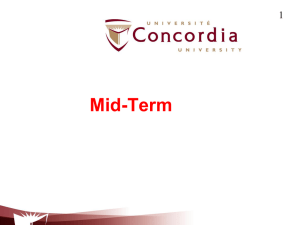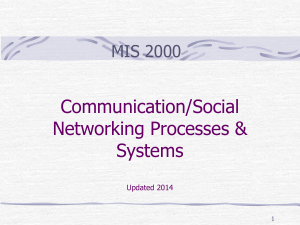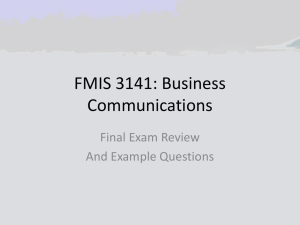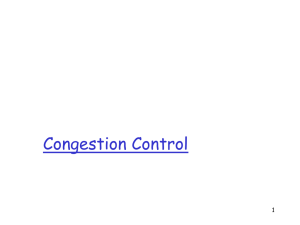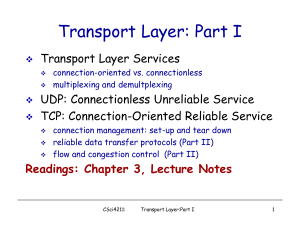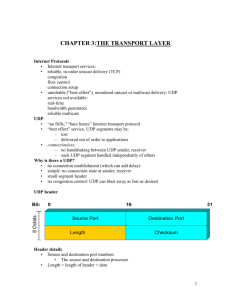ppt - Bob Briscoe
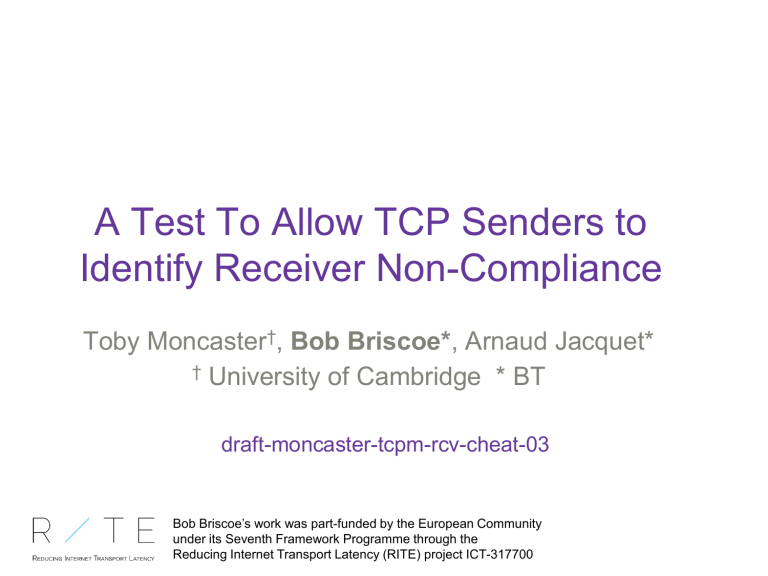
A Test To Allow TCP Senders to
Identify Receiver Non-Compliance
Toby Moncaster
†
, Bob Briscoe* , Arnaud Jacquet*
†
University of Cambridge * BT
draft-moncaster-tcpm-rcv-cheat-03
Bob Briscoe’s work was part-funded by the European Community under its Seventh Framework Programme through the
Reducing Internet Transport Latency (RITE) project ICT-317700
Background and why come to IETF?
● TCP senders rely on accurate congestion feedback from receivers
● A strategising loss-insensitive, e.g. streaming, receiver can:
♦ Send optimistic acks : fool a sender into increasing its rate
♦ Conceal lost data segments: to avoid a congestion response
● These disrupt sharing of sender’s own resources & fool sender into using excess network resources by concealing congestion
Solution is a simple test – draft-moncaster-tcpm-rcv-cheat
● Originally written in 2007
♦ parked for 6 years due to lack of interest/time
● New draft (-03) published July 2014
♦ Want to get community oversight of the proposed tests
♦ Motivated by new interest in this area from large content providers
♦ Also could free-up ECT(1) codepoint assigned to ECN Nonce expt
♦ Have chosen to go to experimental track
Proposed solution
D
SEQ
S-1
S+1
S+2
S+3
S
S+4
S+5
● Based on Sherwood’s Randomly Skipped Segments, but add initial stage to reduce impact on receivers [1]
● Key goal was to leverage existing TCP behaviour
1.
Delay a segment by a small amount and check the responses
ACK
S-1 (-)
S-1 (S)
S-1 (S)
S-1 (S)
S+3 (-)
S+4 (-)
S+5 (-)
● select segment S & displacement D
(2 < D < K-2, K = current window)*
● Segment S transmitted after segment S+D
● Receiver should generate D dup acks
* SACK allows longer gap but shorter reduces harm to receiver
[1] K. Gao student project 2004: http://www.cs.cmu.edu/~kgao/course/15744/network.pdf
Proposed solution
R
.
.
.
.
.
.
.
.
.
.
.
.
● Based on Sherwood’s Randomly Skipped Segments, but we add initial stage to reduce impact on receivers
● Key goal was to leverage existing TCP behaviour
1.
Delay a segment by a small amount and check the responses
2.
Delay a segment until you have seen 3 dup-ACKs
.
.
.
.
.
.
.
.
.
.
.
.
.
.
.
.
R
● Hold back segment S*
Transmit segment S after seeing 3 Dup
ACKs for S-1
● If you see any ACK for a segment >S then receiver has failed
* perform pessimistic cong. response if no SACK
Aims of the experiment
● Primary aims of experiment:
♦ Establish whether this two-stage testing strategy works
♦ Establish whether they cause any harm to other flows, and minimal harm to compliant receivers
● Secondary aim:
♦ see if any receivers use these strategies
● Hope to get content providers to run these tests
♦ Already identified one possible provider
♦ Would love to hear from others
● Experiment would run for one year from adoption
Summary
● Strategising receivers skew a sender’s allocation of its own resources
● Receivers can fool the sender into giving excess network resources to the receiver, risking v high congestion
● This 2-stage test allows senders to identify such receivers
♦ It causes minimal problems for honest receivers
♦ It encourages compliant behaviour:
• The only way to avoid the first test carries a delay penalty
• Second test can’t be avoided
● Only requires modification of sender, so easy to implement
Next steps
● Get draft adopted by WG
● Considering extension to cover concealing ECN marks:
♦ Easy to do if using AccECN ‘cos an introduced CE mark won’t conceal any real congestion for a whole round-trip
♦ Harder with RFC3168 ECN, but possible (send a CE mark followed soon after by setting CWR)
♦ Minimal impact on any actual congestion signal
● Large content provider interested in deploying this
♦ Easier to convince it is safe with expert tcpm review
♦ Implementation will be open source (initially FreeBSD)
draft-moncaster-tcpm-rcv-cheat-03.txt
Questions?
Existing solutions
● Randomly skip segments – hold back a segment and transmit it once a duplicate acknowledgement is received
● Delayed Segments – from Kun Gao, CMU student.
● A transport layer nonce – add a specific nonce to the transport layer which has to be echoed back to the sender
● The ECN nonce* –receiver has to guess correct nonce sum (NS)
[RFC3540] for any lost segment or optimistic ack
*experimental and only for ECN-capable transports
Doesn’t interfere with CC
Utilise existing features
Receiver plays passive role
No negotiable TCP options
Receiver unaware of testing
Able to prove non-compliance?
Doesn’t harm compliant rcvr
Skip Seg Delay seg ECN nonce TCP nonce
x
x x x n/a
x x x n/a
x x

